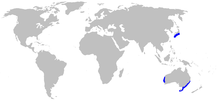Bareskin dogfish
The bareskin dogfish (Centroscyllium kamoharai) is a little-known, deepwater dogfish shark of the family Etmopteridae.[1][2] This species is found in the western Pacific from southern Japan to western and southeastern Australia as well as in New Zealand waters.[3]
| Bareskin dogfish | |
|---|---|
| Scientific classification | |
| Kingdom: | Animalia |
| Phylum: | Chordata |
| Class: | Chondrichthyes |
| Order: | Squaliformes |
| Family: | Etmopteridae |
| Genus: | Centroscyllium |
| Species: | C. kamoharai |
| Binomial name | |
| Centroscyllium kamoharai T. Abe, 1966 | |
 | |
| Range bareskin dogfish (in blue) | |
The bareskin dogfish has no anal fin. It has grooved dorsal spines with the second larger than the first, a smaller first dorsal fin, blunt nose, large eyes, large nostrils, widely spaced and sparse denticles, and is dark in color with white-tipped fins. It is stout and grows to a maximum of 40 cm.[4][5] Like other species in the family Etmopteridae (lanternsharks), the bareskin dogfish has a bioluminescent organ on the ventral side. However, perhaps owing to the depth at which the species lives, it has relatively fewer photophores on its ventral skin than others bioluminescent sharks.[6]
Conservation status
The New Zealand Department of Conservation has classified the bareskin dogfish as "Data Deficient" under the New Zealand Threat Classification System.[7]
References
- Finucci, B. & Kyne, P.M. 2018. Centroscyllium kamoharai. The IUCN Red List of Threatened Species 2018: e.T41746A68615299. https://dx.doi.org/10.2305/IUCN.UK.2018-2.RLTS.T41746A68615299.en. Downloaded on 27 December 2018.
- "Centroscyllium kamoharai". Integrated Taxonomic Information System. Retrieved 6 February 2006.
- Roberts, Clive; Stewart, A. L.; Struthers, Carl D.; Barker, Jeremy; Kortet, Salme; Freeborn, Michelle (2015). The fishes of New Zealand. 2. Wellington, New Zealand: Te Papa Press. p. 141. ISBN 9780994104168. OCLC 908128805.
- FAO Species Catalogue Volume 4 Parts 1, Sharks of the World
- Froese, Rainer and Pauly, Daniel, eds. (2006). "Centroscyllium kamoharai" in FishBase. 06 2006 version.
- Claes, Julien M.; Nilsson, Dan-Eric; Straube, Nicolas; Collin, Shaun P.; Mallefet, Jérôme (Mar 10, 2014). "Iso-luminance counterillumination drove bioluminescent shark radiation". Scientific Reports. 4: 4328. doi:10.1038/srep04328. PMC 3948070. PMID 24608897.
- Duffy, Clinton A. J.; Francis, Malcolm; Dunn, M. R.; Finucci, Brit; Ford, Richard; Hitchmough, Rod; Rolfe, Jeremy (2018). Conservation status of New Zealand chondrichthyans (chimaeras, sharks and rays), 2016 (PDF). Wellington, New Zealand: Department of Conservation. p. 9. ISBN 9781988514628. OCLC 1042901090.
